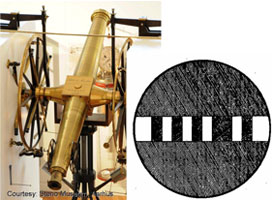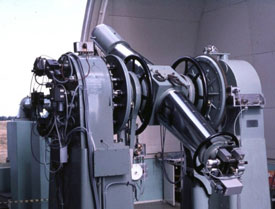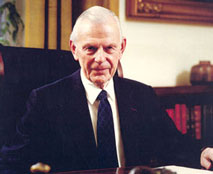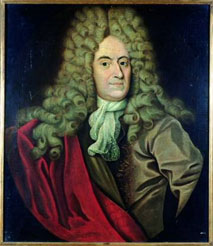Astrometry
An important new development in astrometry began in 1925 when Bengt Strömgren made some experiments on the old meridian circle in Copenhagen.

A meridian circle is a telescope mounted in a special way to make measurements of positions and was invented by Ole Rømer 300 years ago.
The telescope sits perpendicular on an axis, which rests on a column in the east and a column in the west, so that you can only see stars when they cross the north-south direction.
Astrometric results are used in all branches of astronomy to get a physical understanding of the structure of the entire universe - of stars, which are glowing balls of gas - of planets orbiting the Sun and other stars - and of galaxies, which are rotating solar systems, etc.
The observer sees a star enter into the field of view and it glides through due to the rotation of the Earth.
He measures the exact time that the star passes across the meridian and he measures the tilt of the telescope in relation to the horizontal axis by taking a reading of an accurately divided circle, attached to the axis.

These two measurements give the position of the star corresponding to a place's longitude and latitude on Earth.
New method of measurement
Bengt Strömgren was a teenager, just 17 years old, when he showed that stellar positions can be measured when you let a star glide over some slits in the meridian circle. You can capture the light of the star with a photocell that converts the light to an electric current.
The timing of the star's passage over each slit is used to find the position of the star, and this can in principle be measured through the changes in the electric current.
Strömgren's photoelectric technique was the best of his time, but was not yet developed enough that it was practical. But Strömgren's photoelectric technique was the start of an entirely new method of measurement that revolutionised astrometry.
Erik Høg, an astronomer at the University of Copenhagen, knew the principle from his student days and in 1960 he was able to adapt Strömgren's idea to counting photons instead of measuring an electric current and this worked well on meridian circles and also later on the Hipparcos satellite.
Bengt Strömgren

Atomic physics, astrophysics and astrometry
Stars concist of atoms, therefore atoms must be understood before the structure and evolution of stars can be understood. That became possible through the great advances in atomic physics in the 1920s, a development where Niels Bohr and his institute played a central role. There were suddenly entirely new opportunities for understanding the stars and everything else in the universe.
This naturally attracted the sharpest of astronomers and of course the young. One of them was Bengt Strömgren, but he was one of the few who nevertheless continued to promote the "boring" but important astrometry. Erik Høg often told him about his work and Strömgren was active, for example, in setting up a new meridian circle in Brorfelde in 1953 and at the adoption of Hipparcos in 1980.
Ole Rømer

Ole Rømer was born in Århus in 1644 and was involved in preparing a publication of Tycho Brahe's observational records. In 1671 he assisted the French astronomer Jean Picard in measuring the longitude and latitude of Brahe's observatory on Hven - a job which would help with interpreting Brahe's observations more accurately.
Ole Rømer's friends
Ole Rømer Wikipedia
